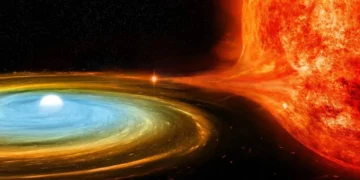The universe is full of cosmic wonders, but very few celestial events are as thrilling and rare as a recurrent nova. One such phenomenon is T Coronae Borealis (T CrB), popularly known as the “Blaze Star.” Located approximately 3,000 light-years away in the constellation Corona Borealis, this binary star system is one of the most famous recurrent novae in the night sky.
What is T Coronae Borealis? The Science Behind the “Blaze Star”
T Coronae Borealis is a binary star system, meaning it consists of two stars orbiting each other. The system includes:
- A white dwarf: The leftover core of a dead star, extremely dense and gravitationally powerful.
- A red giant: A massive star nearing the end of its life, constantly shedding gas into space.
Over time, the white dwarf pulls material from the red giant due to its strong gravity. This gas accumulates on the white dwarf’s surface, gradually heating up. When enough material builds up, it triggers a runaway thermonuclear explosion, releasing an enormous amount of energy in a short period. The result? The white dwarf brightens by 1,000 times in just a few hours, creating what we see as a nova in the night sky.
This is why T CrB is called a recurrent nova—unlike a supernova, which is a one-time catastrophic explosion, T CrB survives each eruption and repeats the process every 78 to 80 years.
Why is T CrB’s Next Nova So Important?
1. A Rare Opportunity for Astronomers
Novae like T CrB don’t happen often, especially ones that can be seen without a telescope. Since its eruptions occur only once in a human lifetime, most astronomers today have never had the chance to study it in real-time using modern technology.
Now, with powerful telescopes, space-based observatories, and improved computational models, astronomers will be able to gather high-quality data to better understand:
- How mass is transferred between stars in a binary system.
- The exact process of thermonuclear runaway that leads to a nova.
- The effects of nova explosions on their surrounding space environment.
2. A Celestial Spectacle for Stargazers
For skywatchers, this is a once-in-a-lifetime event. Unlike distant supernovae, which require powerful telescopes to observe, T CrB’s explosion will make it as bright as Polaris (the North Star), meaning anyone—even in urban areas—will be able to see it with the naked eye.
It will remain visible for about a week, after which it will slowly fade back into obscurity. Given that the next eruption won’t happen until around the year 2100, this is a must-see event for astronomy enthusiasts.
When and Where to See T CrB in the Night Sky
1. When Will T CrB Explode?
Astronomers originally predicted that T CrB would erupt between April and September 2024, based on its historical pattern. However, since it has not yet gone nova, its explosion is expected at any time in 2025. The fact that it is overdue adds to the excitement, as it confirms that a nova is imminent.
2. Best Time to Observe T CrB
T CrB’s host constellation, Corona Borealis, begins to rise in the night sky in March 2025. In the Northern Hemisphere, it becomes visible about three hours after sunset and continues rising earlier as spring progresses.
3. How to Locate T CrB in the Sky
Finding T CrB is easier than you might think! Here’s how:
- Locate the Big Dipper (Plough) in the sky.
- Follow the arc of the handle to find Arcturus, the fourth-brightest star in the night sky.
- Look slightly above Arcturus to find a crescent-shaped arrangement of stars—this is Corona Borealis, the Northern Crown.
- When T CrB erupts, it will appear as an extra-bright “guest star” within this constellation, near Epsilon CrB.
If you have a telescope or binoculars, you can try finding T CrB before it goes nova, although it is currently quite dim at magnitude +10.
What Will Happen When T CrB Goes Nova?
When the explosion occurs, it will unfold as follows:
- Rapid Brightening – T CrB will suddenly increase in brightness by a factor of 1,000, making it visible to the naked eye within hours.
- Peak Brightness – It will reach a magnitude of about +2, making it as bright as Polaris.
- Visible for a Week – The nova will remain bright for about 7-10 days, giving skywatchers plenty of time to observe it.
- Slow Fade – Over the following weeks and months, it will gradually fade back to its normal dim state, where it will remain until its next eruption in about 80 years.
Scientific Discoveries Expected from This Nova
This nova event will provide valuable data for scientists studying:
- Binary star interactions – How mass is transferred between a white dwarf and a red giant.
- Nova evolution – How recurrent novae differ from one-time classical novae.
- Interstellar enrichment – How nova explosions contribute elements like carbon, oxygen, and nitrogen to the galaxy.
This is a major astrophysical event, and telescopes around the world—including the Hubble Space Telescope, the James Webb Space Telescope, and ground-based observatories—will be collecting data as soon as the nova occurs.
Final Thoughts: Don’t Miss This Rare Event!
The eruption of T Coronae Borealis is shaping up to be one of the most exciting astronomical events of 2025. Whether you’re an astronomy enthusiast or a casual stargazer, this is your chance to witness a nova explosion in real-time.
- The explosion could happen any day—so start monitoring the Corona Borealis constellation now.
- If you spot an unexpectedly bright star in the constellation, congratulations! You may be among the first to see T CrB go nova.
- The next explosion won’t happen for another 80 years, so don’t miss this once-in-a-lifetime event!
Keep your eyes on the night sky—the Blaze Star is ready to shine once more!



















